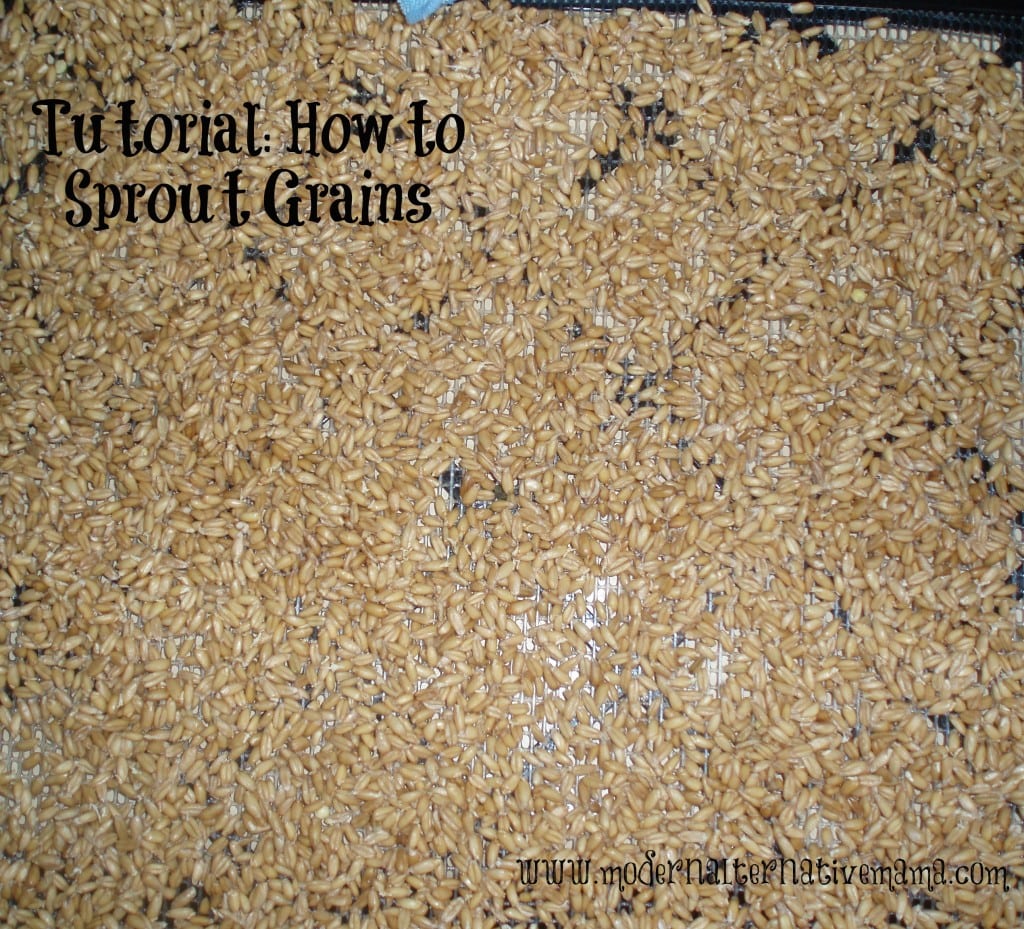Sprouted grains. I’ve mentioned them before, but I’ve never told you HOW to sprout grains, have I? Hence, today’s tutorial. 🙂
Sprouted grains have a ton of health benefits. They’re more easily digested and nutrients more readily absorbed, they are full of extra vitamins, especially B vitamins (did you know that’s why white flour is enriched with B vitamins? Because manufacturers know they should and do contain these, but stripping the bran off gets rid of them), some gluten-sensitive individuals can eat them, they contain few to no anti-nutrients — they’re wonderful! Of course, it’s best to reduce your intake of grains overall, but when you eat them, sprouted grains are the best you can get.
Buying them, though, is extremely expensive. We’re talking about $3/lb to buy it! Since most white flour is only about $0.50/lb and good whole wheat flour (unsprouted) is about $1/lb (as are whole, unground grains), that’s a huge price increase. It may be worth it to some who have more money than time to purchase the sprouted flour, or even to simply buy sprouted grain products, but for most of us, it’s far better use of time and money to sprout grains ourselves. And it really is not much work at all. Most of the time it takes is wait time.
Once you have sprouted your grains, here’s how to bake with them.
How to Sprout Grains
Ingredients/Utensils:
- Whole, unground grains (wheat, spelt, kamut, rye, etc.), amount of your choice
- Clean, filtered water
- Large bowl
- Colander
- Kitchen towel
- Dehydrator or oven that goes down to 120 degrees Fahrenheit
If you know that you can tolerate grains well and want to sprout a lot at once, I’d recommend doing 4 – 5 lbs. (which will fit into a 9-tray Excalibur dehydrator). If you don’t have as much space for drying and/or you just want to try it out, don’t do more than 1 lb. this first time.
First, place your grains in a nice, large bowl. You need extra room for water.
Then, pour in enough water to cover the grains by at least an inch. They’ll absorb a lot so check in an hour or so to see if you need to add a bit more. They should be covered completely and will soak overnight or about 6 – 8 hours.
After soaking overnight, pour the grains into the colander to drain them.
Rinse the grains thoroughly with water. You will do this every 8 – 12 hours until they are sufficiently sprouted (which will take 1 – 2 days). They need to remain wet. If the weather is hot and humid, this is ESPECIALLY important, because otherwise the grains will grow fuzzy mold and need to be thrown out. Guess how I know?
Once your grains have short tails on them, about 1/4″, then are ready. There is no harm in leaving them longer and I often do. Some may be quite a bit longer and this is fine. Rinse them one final time before drying.
See the little tails on them?
Now, put the grains on dehydrator trays or on large baking sheets (the kind with edges).
Put them in the dehydrator (or oven) at about 120 degrees for 4 – 5 hours, until they are completely dry. If they’re not, they could get moldy and will certainly clog your grain mill or blender.
When they are done, transfer them to bags and store in the freezer until you need them. It’s best to grind them as you need them. If you must grind at once, definitely store in the freezer for no longer than one month (otherwise the oils will go rancid and they will lose a lot of vitamins).
You can grind your grains in a special grain mill, or you can use a good quality blender like a Vitamix. I use my Vitamix for grinding mine and can get a coarse texture for a “rustic” type of bread or cracker, or a nice fine texture for smooth, wonderful baked goods. Grinding time is everything. 🙂
Sprouted flour can be used successfully in many recipes. It doesn’t bake exactly like unsprouted flour, but it’s pretty similar. Yeasted bread will take longer to rise, but most cookies and quick breads do just fine.
That’s sprouting flour! Easy, no?














Thanks for this! I keep hearing how easy it is, but I still am glad to have a guide to follow!
I noticed you place the grains directly on the screens, as I do. However, I keep losing some grains through the mesh, so I placed a piece of parchment paper in the bottom of my dehydrator to catch the smaller ones who like to live life on the edge! Then all I need do is pull the paper out and add those grains back in.
I do keep hearing different temperatures to use in drying grains. Some say not to go above 105, others say 150 is okay. And 5 hours? Are they really dry after only 5 hours? And if I go over 5 hours, will the nutrition suffer? I don’t want to overdo it, but I’m like you, I don’t want to clog my mill. Thanks for posting this. I’m still in the learning process here!
Hi Naomi,
My grains tend to be dry after 5 hours (or less), but I’ll confess, if I’ve been good about rinsing them during the sprouting I often don’t rinse them again before putting them in and I’m sure this reduces the time it takes to dry! 115 – 120 degrees is the temp. at which enzymes are killed so best not to go above that if you can avoid it. Taking longer to dry at a lower temp is fine and it won’t affect the nutrition. Higher temps will though.
Cool trick about putting parchment paper on the bottom! I should really do that! 🙂
Do you keep the bowl full of water between rinses, or do you just keep them in the bowl without water after the initial soak?
Bekah (seems funny writing that, it's my daughter's name! 🙂 ): Just leave them in a bowl or colander between rinses so they are wet but not soaking once they are done with the initial soak. They could get moldy if they are soaked too long. It should only take 24 – 36 hours to sprout sufficiently after the soak. 🙂 Hope that helps!
Such a helpful post! A friend just recommended your blog as I was asking about sprouting my wheat berries. I think I'm all set, just need/want a dehydrator. Can't wait to try it out!
Now, I'm off to explore your blog : )
Sorry, this may seem like a silly question, but how do you know when the grains are dry? I checked mine at 5hrs and they weren’t damp or anything, but they didn’t seem super dry, either. Is that correct? What should I be looking for in consistency? Thanks!
They should be hard when they are dry. 🙂